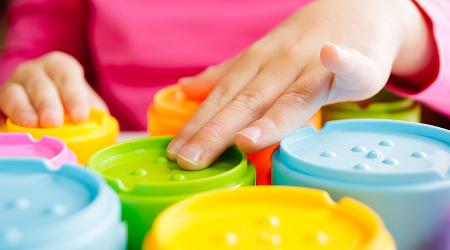
Sensory Stimulation: What It Is and How It's Used
Share
Sensory stimulation is the input and sensation you receive when one or more of your senses is activated.
This type of stimulation is important for infant development and can be used to improve the well-being of developmentally disabled adults, people with neurocognitive disorders, and older adults.
Keep reading to learn more about sensory stimulation, what exactly it is, and the benefits it provides.
The 5 human senses
Sensory stimulation is the activation of one or more of our five senses:
- Seeing (visual): When light passes through your cornea (transparent eye surface) to your pupil (the opening to the inside of your eye). After passing through your pupil, it reaches your lens, which focuses it on your retina (the back of your eye), where it’s converted into a nerve signal and carried by your optic nerve to your brain.
- Hearing (auditory): When sound vibrations cross your eardrum to your inner ear, change into nerve signals, and are transmitted to your brain by your auditory nerve.
- Touching (tactile): When nerve endings (receptor cells located throughout your body) transmit signals to your brain and it interprets them as pain, pressure, vibration, temperature, and body position.
- Tasting (gustatory): When your approximately 10,000 taste buds (receptor cells) send signals to your brain, identifying sweet, salty, sour, bitter, and umami (savory) flavors. Taste is also affected by also the smell, temperature, and texture.
- Smelling (olfactory): When specialized cells (olfactory sensory neurons) high in your nose send signals to your brain for interpretation and identification. There are also olfactory sensory neurons on the roof of your mouth.
Sensory stimulation for babies
Because babies learn about the world around them with their senses, sensory stimulation is linked to:
- emotional development
- cognitive development
- physical development
Repetitive activities that stimulate the senses can help babies learn and reach developmental milestones.
Examples of sensory stimulation for babies include:
- rattles
- mobiles
- hearing lullabies
- toys
- peek-a-boo games
- bath time
Sensory stimulation for young children
Sensory stimulation continues to be beneficial as babies progress from infants to preschoolers. Sensory play helps children engage with the world in a way that helps them grow and develop.
For young children, sensory play includes any activity that stimulates a child’s sense of touch, smell, taste, sight, movement, and hearing. This kind of play helps create connections in the brain that allow for more complex thoughts and tasks. Sensory activities also help young brains better process and respond to sensory information.
For example, a child may find it difficult to play with another child if there are other sensory stimulations — such as loud noises — in their environment. Through sensory play activities, the child can learn to block out stimulations that are not as important and focus on ones that are, such as social interactions with another child.
Sensory play also supports language development, cognitive growth, motor skills, and problem-solving skills.
Sensory stimulation activities for children include:
- banging on drums (or anything that makes a noise)
- playing in a sandbox
- adding food coloring to water
- making smoothies
- blowing whistles
- making shadow puppets
- playing catch with a balloon
- comparing sweet and savory snacks
- finger painting
Sensory stimulation for those with neurocognitive disorders
Sensory stimulation has been widely used in caring for people with neurocognitive disorders, previously referred to as dementia. Typically, this uses everyday objects to evoke positive feelings through the arousal of the senses.
According to the Alzheimer’s Society, sensory stimulation activities for people with neurocognitive disorders include:
- preparing or cooking food
- playing board games or working on puzzles
- singing or playing instruments
- painting or drawing
- receiving a hand massage
- dancing
- walking
A
A
- depression
- agitation
- aggression
- delusions
- sleep disturbances
Sensory stimulation for developmentally disabled adults
According to a 2010 study, sensory stimulation through visual, tactile, gustatory, auditory, and olfactory activities can enhance the lives of low-functioning developmentally disabled adults by giving them more opportunities to use their senses and communication skills.
Some examples of sensory stimulation for developmentally disabled adults include:
- puzzles
- scented markers
- talk radio
- weighted blankets
- fidget toys
Sensory stimulation can also improve the well-being of older adults with or without neurocognitive disorders by calling up positive memories, reinforcing relationships with loved ones, and
Sensory stimulation activities for older adults could include:
- listening to different types of music
- listening to recordings of natural sounds
- touching items with varying textures, such as sandpaper, pine cones, shells, and stones
- light therapy
- movies and videos
- photos of loved ones
- optical illusions
- gardening
- essential oils, such as peppermint, lavender, bergamot, and rosemary
- tasting foods, such as berries, coconut, black and green tea, and cinnamon
Takeaway
Sensory stimulation is the response to input from our environment by one or more of our five senses:
- visual (seeing)
- auditory (hearing)
- tactile (touching)
- gustatory (tasting)
- olfactory (smelling)
Sensory stimulation is very important for the development of infants and can be used effectively to improve the well-being of developmentally disabled adults, people with neurocognitive disorders, and older adults.
Visit our website https://realyoustore.com/ to learn more about sensory!
